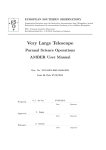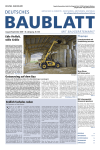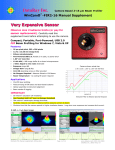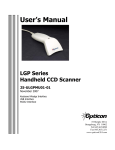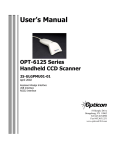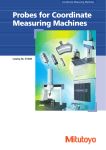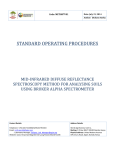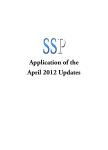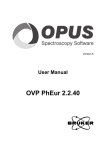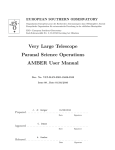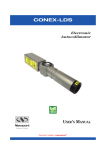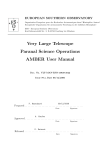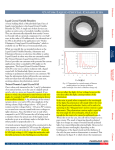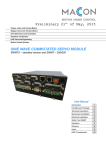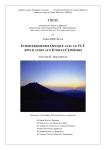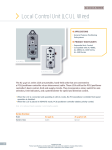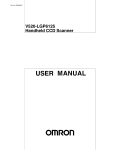Download ARAL: a facility to fuel VLTI instruments with photons
Transcript
ARAL: a facility to fuel VLTI instruments with photons Sébastien Morel∗ a , Martin Vanniera , Serge Ménardib , Fabio Biancat-Marchetb , Michael D. Fischera , Philippe Gittonb , Andreas Glindemannb , Stéphane Guisarda , Nicolás Haddada , Nico Housena , Alexis Huxleyb , Mario Kiekebuscha , Antonio Longinottib , Thanh Phan-Ducb , Markus Schöllera , Anders Wallanderb a European Southern Observatory, avenida Alonso de Córdova 3107, Casilla 19001, Vitacura - Santiago, Chile; b European Southern Observatory, Karl-Schwarzschild-Straße 2, 85748 Garching-bei-München, Germany ABSTRACT The ARAL system of the VLTI is a multipurpose facility that helps to have the interferometric instruments ready for night observations. It consists of an artificial source (allowing a Mach-Zehnder mode of the interferometric instruments for autotest), an alignment unit (verifying the position of the celestial target in the VLTI field-ofview), and an optical path router (controlling the optical switchyard and the instrument feeding-optics in the VLTI laboratory). With the multiplication of VLTI instruments and their specific features (wavelength coverage, number of beams), an upgrade of ARAL (from its November 2002 version) had to be carried out: the alignment unit has been redesigned, as well as the artificial source. This source will provide a point in the visible and in J, H, K and N infrared bands, split into four beams (with a zero optical path difference at the reference position). After a description of the optomechanics and of the computer architecture of ARAL, we detail the difficulties of building an interferometric artificial source with a wide spectral range. Keywords: interferometric instruments, optical alignment, artificial source. 1. INTRODUCTION One difficulty of long baseline interferometry is the complexity and the length of the optical paths. The requirement of Coudé foci for the telescopes, of delay-lines and the possibility to select one (if not a pair) among several instruments, imply a large number of mirrors, and a narrow field-of-view. Another challenge is the pointing and tracking accuracies, that are required to overlap the beams inside the instrument. When the celestial object to be acquired is within the maximum available field-of-view, it should be possible to monitor the position of the object for each beam. From this information, the telescope pointing can be corrected, in order to bring the centroid of the object at an optimal position for the instrument. Moreover, it is important for some instruments to have a daily health check of their intrinsic interferometric transfer function (fringe contrast for an unresolved source). This monitoring requires an artificial source providing coherent beams. Such a device can also help to diagnose instrument problems like a failure of the piezo modulator (used to generate interferograms by scanning the optical path difference – OPD – between the beams). A modern interferometric facility must also be able to host several instruments, depending on the type of science to be done. Each instrument has specific features such as spectral range, spectral resolution, number of beams to be recombined, etc... It is therefore important to be able to seamlessly switch from one instrument to another one, or to use several instruments at the same time. This implies the use of computer-controlled motors that can translate and rotate mirrors and dichroics to quickly change the optical path inside the room (“laboratory”), where the instruments are installed. The system providing all the above functionalities for the VLTI is called ARAL (ARtificial source and ALignment unit). It currently consists of: ∗ E-mail: [email protected] • An interferometric spatially-coherent source, providing two coherent beams with λ from 0.6 to 5 µm, and in the future four coherent beams with λ from 0.6 to 5 µm, and probably also λ from 8 to 13 µm. • An “alignment unit”, consisting of a technical CCD (TCCD), sensitive in the visible spectrum, mounted on a sighting-telescope (refractor) that is aligned on the reference axis of the VLTI. This alignment unit features an optomechanical system to image any of the VLTI stellar beams, focusing either at the infinity or at the entrance pupil plane. • A beam routing system inside the VLTI laboratory, consisting of switchyard mirrors and feeding-optics mirrors and dichroics. All the positions of these optics can be remotely controlled . As we see, ARAL offers more functionalities than its acronym would suggest. This comes from “historical” reasons. 2. ORIGINS OF ARAL The first instrument of the VLTI, called VINCI,1 was dedicated to commissioning mostly. It featured an interferometric artificial source called “Leonardo”, as well as an alignment checking device called ALIU (ALIgnment Unit). Because of the arrival of instruments like AMBER2 or MIDI3 working with more than two beams (three for AMBER) or in specific wavebands (N-band for MIDI), and requiring new feeding-optics, it has been decided to remove the control of Leonardo and ALIU from VINCI, and to build a “hidden” instrument called ARAL, that would control ALIU and Leonardo. At the same time, we realized that a machine would be needed to control the switchyard (after motorization) and the feeding-optics of the future VLTI instruments. These tasks have therefore been delegated to ARAL. 3. COMPUTER ARCHITECTURE OF ARAL ARAL consists of a Unix workstation (waral) and of three LCUs (local control units), which are VME-bus chassis. Each LCU uses a PowerPC CPU board running under VxWorks (real-time OS) with the VLT LCU common software. User workstation or X-terminal wvgvlti WS (ISS) waral WS (OS, ICS, DCS) VLTI instrument (MIDI, VINCI, AMBER) OS (operated through BOB) Network larics1 LCU (ICS) larics2 LCU (ICS) Interferometer supervisor software (ISS) lartccd LCU (DCS) ARAL ICS GUI Photons Artificial-source lamps M M ALIU and Artificialsource motors M M ARAL DCS GUI ARAL OS ARAL ICS ARAL DCS Motors TCCD M Switchyard and feeding-optics motors Technical CCD Fig. 1. Hardware computer architecture of ARAL (left) ; and Software architecture (right). Table 1. ARAL motor list Motor name Switchyard Artificial source Alignment unit MIDI feeding-optics VINCI feeding-optics FINITO feeding-optics AMBER feeding-optics PRIMA/MIDI laser optics PRIMA FSU-A feeding optics IRIS feeding optics Type Rotation Translation Translation Rotation Translation Rotation Rotation Translation Translation Translation Quantity (current) 3 2 3 2 2 3 3 0 0 0 Quantity (future) 8 4 3 2 2 3 3 2 2 3 The LCU called lartccd is dedicated to the control of the TCCD of the alignment unit. The LCU larics1 controls the motors of the alignment unit and of the artificial source, as well as the lamps and the “K-laser” (see Sect. 6.1) of the artificial source. The third LCU, larics2, controls the motors of the switchyard and of the feeding-optics of the instruments. The software architecture of ARAL is similar to any standard VLT instrument,4 based on CCS (central control software). Its core is the observation software (OS), which is the front end for the VLTI ISS (interferometer supervisor software). The OS dispatches the received commands to the ICS (instrument control software) and to the DCS (detector control software). The ICS controls the ARAL motors and the light sources. A part of the ICS (the low level motor control) runs within larics1 and larics2. The DCS controls the readout of the TCCD of the alignment unit. It is based on the standard VLT TCCD software, and includes a modified version of the RTD (real-time display) panel, allowing the operator to set the integration time easily. This RTD includes the possibility to “pick” in the field-of-view the celestial object to be centered. Any VLTI instrument that requires action from ARAL has to do it by sending a command to ISS that is then forwarded to the ARAL OS. These commands are included in the instrument “templates” used for building observation blocks. The control of the ARAL devices can also be done manually, through the ICS GUI controlled by the operator. 4. MOTOR CONTROL Each ARAL mechanical device features a DC motor, an incremental encoder, and a tachometer. For linear (or translation) motions of optics, Schneeberger (Switzerland) translation stages have been procured. For rotary motions of optics, we have chosen rotation stages from Newport/Micro-Contrôle (France). The list of the motors is given by Table 1: currently, a total of 18 motors is controlled by ARAL. Once the 1st generation VLTI facility is fully integrated, 32 motors (including the future feeding-optics for the PRIMA fringe sensor units,5 and for the IRIS infrared tip-tilt sensor6 ) will be controlled by ARAL. An extra LCU will be required then. The specifications of positioning accuracy of ARAL devices are ± 100 µm for a mirror translation along its normal direction, ± 200 µm for a mirror translation along its plane, and ± 5 arcsec for a mirror rotation. These specifications are fully met by the Schneeberger and Newport stages we have procured. The motor control system is ESO standard, and has successfully been used in the past on numerous instruments and subsystems at Paranal Observatory: each motor is controlled in position by a VME Maccon board, and in velocity by an ESO custom-made VME4SA DC servo amplifier board.7 The Maccon board computes in real-time a velocity order from the actual positioning error given by the position encoder. This velocity order is sent to the amplifier board which controls the motor current according to the received velocity order and the actual velocity read from the tachometer. Each Maccon and VME4SA board pair can control up to four motors. V U Trioptics focus ARAL LCUs Pupil lens Switchyard optics AMBER feeding optics FINITO feeding optics VINCI feeding-optics MIDI feeding optics Artificial source optics ALIU : existing rotation stage : rotation stage in project : existing linear stage : linear stage in project : other existing motor incoming beam (from M16) Fig. 2. VLTI laboratory layout with the locations of the ARAL-controlled motors. Grey lines: possible routing for the optical beam SWD-4-I, also known as “beam A” (see Sect. 5.2). 5. THE ALIGNMENT UNIT 5.1. Purpose of ALIU At the beginning of a VLTI run using the 8.2-m VLT Unit Telescopes (UTs), it is important to check that the optical path is free. This is done for each beam by switching on a beacon (halogen lamp) located near the Nasmyth focus of the corresponding telescope, downstream of the M4 mirror. The image of this beacon should be seen on the ALIU TCCD. The alignment of instruments like VINCI or AMBER also uses ALIU. By retro-illuminating their fibers, a spot is seen on the TCCD. It should correspond to the spot from the artificial source. These spots define the “reference pixels” of the instruments for each beam in autotest. On sky, the reference pixel is defined for each beam by the center of the field-of-view of the VLTI as seen on the ALIU TCCD, for example by pointing at the Moon. During the acquisition phase, the centroid of the star image must be moved to the reference pixels. For each telescope, and from the centroid in the field-of-view of the ALIU TCCD, the measured error vector is converted into an alt-az offset, in the case of the VLTI with siderostats. In the case of the VLTI with the UTs, an offset computed from the error vector is applied to the Coudé guider which controls the UT secondary mirror. These procedures are iterated until the error vector is smaller than a threshold. From the operator side, the procedures are identical, whether the telescopes for the VLTI are the siderostats or the UTs. In the case of MIDI, since this instrument has an imaging mode with a small (2 arcsec) but sufficient fieldof-view, the ALIU TCCD is not required for the stellar acquisition procedure. 5.2. Latest upgrade In the VLTI laboratory, eight parallel stellar beams are running from the switchyard to the instruments. These beams are named “SWD-x-I” or “SWD-x-S”. SWD means “switchyard” (where these beams come from), ‘x’ is an identifying number (from 1 to 4), ‘I’ means that the beam feeds a VLTI scientific instrument, and ‘S’ that it feeds a technical sensor. Commonly, we call SWD-4-I “beam A” and SWD-3-I “beam B” (note that this convention is reversed for MIDI !). The nominal OPD between any pair of SWD-x-I/S beam is zero (see Sect. 6.1). The original ARAL alignment unit was installed on the VINCI table and featured an optical setup allowing image acquisition from two VLTI beams only. The original upgrade plan was designed for a four-beam version of ALIU. The idea was to place a long linear stage on the MIDI feeding-optics (FO) table of the VLTI laboratory to “intercept” one among the four instrument beams and feed it into the TCCD (moved to a corner of the MIDI FO table, along with its sighting-telescope). However, the possibility to also look at the PRIMA beams was later considered. Therefore, the ALIU upgrade had to be foreseen for eight beams. This required a 1680-mm range (at least) translation stage. Unfortunately, the longest translation stage available from Schneeberger (NCB-76 series) had a 1490-mm range, and was therefore able to check the alignment of seven beams. It has been decided that the beams observable by ARAL would be SWD-2-I to SWD-4-I and SWD-1-S to SWD-4-S, in order to be able to check the alignment of the PRIMA fringe sensor units5 (FSUs). In the future, the SWD-1-I beam can be accessible by upgrading ALIU (mounting a small linear stage on the carriage of the NCB-76 to extend its range, for example). VINCI feeding-optics Retroreflector Linear stage (TMF3-100) for the pupil lens BS cube on linear stage (TMF3-100) Sighting telescope Mirrors on linear stage (NCB-76) TCCD VINCI feeding-optics BS cube on linear stage (TMF3-100) To VINCI VINCI table V Retroreflector U Beam A Beam B From the telescopes PRIMA beams Beam C Beam B Beam A MIDI reference plate SWD-2-I SWD-3-I SWD-4-I SWD-1-S SWD-2-S SWD-3-S SWD-4-S Linear stage (TMF3-100) for the pupil lens To MIDI MIDI feeding-optics table Sighting telescope TCCD Linear stage (NCB-76) BS cube U Retroreflector To VINCI, AMBER, PRIMA V Fig. 3. ALIU in its original two-beam configuration (top) ; and the proposed upgrade (bottom). The carriage of the NCB-76 translation stage supports a CaF2 50/50 beamsplitter (BS) cube, as well as a retro-reflector (corner cube). It is therefore possible, not only to directly visualize a beam coming upstream from VLTI optics, but also to visualize retro-illuminated instruments, like VINCI, which use fiber optics. This allows the internal alignment of such instruments on the VLTI reference frame. The sighting-telescope (taken from the old ALIU) has been manufactured by Trioptics. Its focal length is 300 mm, and its focus can be remotely adjusted by the ARAL ICS. Also, a “pupil lens” (f = 300-mm achromat) is mounted on the carriage of a 100-mm Schneeberger motorized translation stage (TMF3 series). It can be slid in front of the sighting-telescope to visualize the VLTI entrance pupil. The TCCD is coupled to the sighting-telescope via a relay lens that provides a 1.15 magnification. Therefore, the effective focal length of the sighting-telescope is 345 mm. This TCCD8 has a 290 × 386 pixels resolution (each pixel has a 22 µm × 22 µm size), and a 24 ē readout noise. The integration time can be set between 10 ms and 30 s. It can continuously be read out, and the frames are displayed on the RTD (real time display) of the operator’s control workstation. The upgrade of ALIU to seven beams took place in January 2004 and lasted one week (integration + verification). The most delicate part was the alignment on the VLTI reference beam (defined by removable targets put on fixed frames). Nevertheless, the system is now fully operative. TCCD head Retroreflector (back) Pupil lens on linear stage Beamsplitter cube Focus motor Sightingtelescope entrance Pupil lens on linear stage Sighting-telescope (Trioptics) NCB-76 linear stage Fig. 4. The new ALIU as it has been integrated in the VLTI laboratory. 6. UPGRADE OF THE ARTIFICIAL SOURCE 6.1. Purpose of the artificial source An artificial source for an interferometer must be the equivalent of an artificial calibrator star. It should therefore consist of a unique polychromatic point source which is split into different beams. Each beam from the source feeds one of the instrument optical inputs. The OPD between the beams from the artificial source is known by design and is used as a reference for tuning the internal optical OPD of the instrument. In the VLTI laboratory, right downstream of the switchyard, the OPD between all the SWD beams is nominally zero when crossed by a ‘v’ axis. The current artificial source corresponds to the original design of Leonardo (Fig. 5), but is now fully controlled by ARAL. It consists of lamps installed in an integrating sphere (a gold-coated spherical cavity) procured from LabSphere, Inc. (New Hampshire). The light from the sphere is injected into a single-mode (for the K-band) fiber. The other end of the fiber is plugged onto the back of a drilled flat mirror, at a position corresponding to the focus of a parabola mirror. The resulting 18-mm collimated beam (reflected by the drilled mirror) is split by a CaF2 BS cube. Each beam is then sent to the instrument, either directly (“autotest” mode), or upstream to the VLTI optics (“autocollimation” mode). In autocollimation mode, retro-reflectors can be installed at various points in the VLTI optical beam to send the light back to the instrument. This allows, for example, to test the delay line control. As an option, instead of the single-mode fiber coming from the sphere, a fibered HeNe red laser (to provide a visible source for visual alignment) or a fibered 2.3-µm K-laser (long-coherence source for engineering tests with VINCI) can be plugged onto the back of the drilled mirror, as primary sources. Though autotest is daily used for VINCI for health check (measurement of the splitting ratios of the MONA fiber beam combiner), autocollimation is used for special engineering tests only. Currently, the Leonardo source can only be used for two-beam instruments in K-band (i.e., mostly for VINCI). Therefore, its upgrade is necessary for the new VLTI instruments. 6.2. Different designs for the future VLTI artificial source The upgrade of the artificial source of the VLTI is still pending. The main difficulty has been to determine which features would be needed for this source, depending on the requirements for each instrument. For example, AMBER needs a three-beam source. MIDI may require a N-band (8 to 13 µm) source. In the case of the existing FINITO fringe-tracker of the VLTI,9 there are some requirements regarding the polarization of the beams produced by the source. Moreover, using BS cubes for feeding an instrument in autotest has been proved to be useless (imaging both the source and a stellar object on the ARAL TCCD or on the instrument is never done), and these BS cubes can be replaced by flat mirrors (having a better reflection for all the considered wavelengths, and more robust mounting systems). Also, BS cubes for autocollimation can be replaced by mirrors. These mirrors are designed and adjusted to only reflect the lower half of each beam from the artificial source. After reflection by corner cubes (located anywhere in the VLTI optical train), each returned clipped beam would pass just above the edge of its autocollimation mirror to reach the instrument. This would help to eliminate the polarization problems, critical for FINITO in autocollimation. To the instruments BS cube for autocollimation OPD=0 here BS cube Parabola Drilled flat mirror 120 Single-mode fiber 120 BS cubes for autotest (in position) Lamps Integrating sphere V U 240 From the telescopes BS cube for autocollimation Detail of the fiber plugged onto the back of the drilled flat mirror Fig. 5. Drawing of the current “Leonardo” VLTI artificial source. Dimensions are in mm. 6.2.1. Classical beamsplitter design Using beamsplitters, as in the original Leonardo system, a new design (Fig. 6) has been imagined for a four-beam artificial source using three beamsplitters. The condition that the OPD between the beams is zero when crossed by a ‘v’ axis is respected. This design has the disadvantage to rely on beamsplitters, with all the problems of polarization this may imply. Moreover, for the N-band source, CaF2 cubes would have to be exchanged for ZnSe plates (see Sect. 6.3). In this case, due to the high refraction index of ZnSe (2.44 at λ = 2.2 µm, and 2.41 at λ = 10 µm), antireflection (AR) coatings are required. However, it is difficult to imagine an AR coating that would transmit from 0.6 µm (for visible alignment) to 13 µm. Moreover, it is also difficult to elaborate a beamsplitting coating with a 50/50 reflection-transmission ratio (R/T ) over this spectral range. The option would be to have two sets of beamsplitters: the existing CaF2 cubes, and the ZnSe BS plates with compensators. One set of this optics (either CaF2 or ZnSe) would rest on a “cone-groove-plane” kinematic mounts of the artificial source opto-mechanical setup, while the other set is on-the-shelf temporarily. Hence, it would be possible to manually switch between the “short wavelengths” mode and the “long wavelengths” mode quickly. Since the usage of the N-band source is expected to be rare, an automatic or remote switching from the ARAL software is not required. Light source N-band (MM fiber) To the instruments OPD=0 between any pair of beams along beam axis BS0 Light source JHK-bands (SM fiber) BS1 120 120 BS2 120 120 120 120 120 120 This distance can be anything V U 120 From the telescopes Fig. 6. Design of a 4-beam artificial source for the VLTI using beamsplitters. Only the autotest mode is shown here. This design includes the N-band source (see Sect. 6.3). Dimensions are in mm. 6.2.2. Split pupil design Due to the problem of finding beamsplitter elements with R/T = 50/50 over a wide spectral range, and due to the polarization problems that such elements may have, an alternative would be to spatially split the collimated beam from the source using a mask (Fig. 7, left). In the plane of the mask, the OPD between two rays of any pair is zero. The optics downstream of this source need to be designed to keep this property up to the parallel propagation of the beams along −u to the instrument. The advantage of such an artificial source is indeed the absence of any chromatism problems (that we may have with beamsplitters). Hence, it is really possible to have a source with a wide spectral range. The current plan10 would be to have a vertical collimated beam, split into 4 beams with a smaller diameter. This collimated source would be installed on the Leonardo table. The design (Fig. 7, right) includes extra feeding-optics (that might be controlled by ARAL) for one of the PRIMA fringe sensor units. An extra breadboard and table would be required. The current masked primary source project does not include the N-band. Nevertheless, the general layout might include the N-band artificial source (see Sect. 6.3) for the two beams of MIDI. In this case, the ZnSe beamsplitter, the ZnSe compensator plate, and the mirror to feed the beam SWD-3-I (corresponding to the beam A of MIDI) would be mounted on the carriage of a motorized linear stage that could be slid in the optical path whenever an autotest with MIDI is required. Beam D Beam A Beam B Beam C Mask Collimator Fiber exit Fig. 7. Drawing of the VLTI “split-pupil” artificial source project (the principle is illustrated on the left hand). 6.3. Design of an N-band artificial source It was originally planned for MIDI, to have the CaF2 BS cubes of Leonardo replaced by ZnSe BS cubes (using the design described in Sect. 6.2.1), and a single-mode fiber for N-band (bringing the light from the integrating sphere to the focus of the collimating parabola). This fiber could be plugged instead of the K-band single mode fiber, whenever an autotest with MIDI had to be done. However, some problems arose: • Manufacturing ZnSe BS cubes appeared to be difficult, because the cements that could be used to assemble two half-cubes have a strong absorption in the N-band. • Single-mode fibers in N-band do not exist yet for the length we needed (≈1 m). The solution was therefore to use ZnSe BS plates with compensation plates (to avoid chromatic dispersion) instead of ZnSe BS cubes. Regarding the fiber, we procured a set of multimode chalcogenide (As-Se-Te) onemeter fiber bits, transparent for the N-band and manufactured by Amorphous Materials, Inc. (Texas). The diameter of the core of this fiber is 100 µm. A new problem arose when we wanted to have Diamond E-2000 connectors (standard Leonardo/VINCI connectors) crimped at the ends of the fiber bits to make patchcords. It happened to be impossible to do it, due to the fragility: the test fiber bits broke during the operation. Anyway, such a patchcord, plugged in at the focus of the existing collimating parabola of Leonardo, would have yielded a big spot on MIDI, not really representing a point source. The alternative consists in crimping a fiber bit into a chuck at each end. The chuck at the fiber exit is mounted at the center of an XYZ manual linear stage, and the light is collimated by an extra parabola with a different focal length, and then reflected by an extra drilled mirror. This optical setup would feed the first beamsplitter at 90◦ from the current K-band source (see Fig. 6) if the beamsplitter 4-beam source design were implemented. Nevertheless, low-temperature filament lamps for the N-band source have already been procured (from LabSphere) and installed in the integrating sphere. They can be remotely controlled from the ARAL software. 7. CONCLUSION We have presented an auxiliary (but a real) instrument that every night serves the scientific instruments of the VLTI. The diversity of the VLTI instruments, whether they are in operation already, or are under commissioning, or will be integrated in the future, is a challenge for the evolution of ARAL. Its upgrade (regarding especially the artificial source functionalities) is still under development, but many plans have already been studied, and we are now converging towards a realistic solution. We hope that our experience with ARAL will be useful for the design of any future interferometer: a centralized facility like ARAL, that can be controlled by any scientific instrument seems mandatory to have an efficient interferometer. ACKNOWLEDGMENTS We thank Volker Heinz and Erich Bugueño at Paranal Observatory, as well as the team of the mechanics workshop at La Silla Observatory, for having helped us to realize some parts of the ARAL upgrade. We are grateful to Koen Engels (student at Technische Hogeschool Rijswijk, The Netherlands) for having made some drawings of these parts. We also thank Cristián Herrera and Andrés Zarate (telescope and VLTI operators), for their help during the integration of the new alignment unit. REFERENCES 1. P. Kervella, V. Coudé du Foresto, A. Glindemann, and R. Hofmann, “VINCI: the VLT Interferometer commissioning instrument,” in Interferometry for Optical Astronomy II, P. J. Léna and A. Quirrenbach, ed., Proc. SPIE 4006, pp. 31–42, 2000. 2. R. Petrov, F. Malbet, G. Weigelt, F. Lisi, P. Puget, P. Antonelli, U. Beckmann, S. Lagarde, E. Lecoarer, S. Robbe-Dubois, G. Duvert, S. Gennari, A. Chelli, M. Dugué, K. Rousselet-Perraut, M. Vannier, and D. Mourard, “Using the near infrared VLTI instrument AMBER,” in Interferometry for Optical Astronomy II, W. A. Traub, ed., Proc. SPIE 4838, pp. 924–933, 2003. 3. Ch. Leinert, U. Graser, L. B. F. M. Waters, G. Perrin, W. Jaffe, B. Lopez, F. Przygodda, O. Chesneau, P. Schuller, A. Glazenborg, B. Grimm, W. Laun, S. Ligori, J. Meisner, K. Wagner, E. Bakker, B. Cotton, J. de Jong, R. J. Mathar, U. Neumann, and C. Storz, “Ten-micron instrument MIDI: getting ready for observations on the VLTI,” in Interferometry for Optical Astronomy II, W. A. Traub, ed., Proc. SPIE 4838, pp. 893–904, 2003. 4. A. Wallander, J. Argomedo, P. Ballester, B. Bauvir, M. Comin, R. Donaldson, P. Duhoux, A. Gennai, B. Gilli, N. Housen, A. Huxley, R. Karban, M. Kiekebusch, A. Longinotti, I. Muñoz, and T. Phan-Duc, “Status of VLTI control system: how to make an optical interferometer a data producing facility,” in Advanced Telescope and Instrumentation Control Software II, H. Lewis, ed., Proc. SPIE 4848, pp. 95–106, 2002. 5. F. Cassaing, C. Coudrain, B. Fleury, P. Madec, A. Glindemann, S. Lévèque, “Optimized fringe tracker for the VLTI/PRIMA instrument,” in Interferometry for Optical Astronomy II, P. J. Léna and A. Quirrenbach, eds., Proc. SPIE 4006, 2000. 6. P. Gitton, S. Lévèque, G. Avila , “IRIS: an infrared tip-tilt sensor for the VLTI,” in New Frontiers in Stellar Interferometry, W. A. Traub, ed., Proc. SPIE 5491, 2004. 7. B. Gustafsson, CCS-LCU servo amplifier driver user manual. ESO, 2001. VLT-MAN-ESO-17210-0361 - v. 1.4. 8. M. Cullum, Technical CCD systems, operation manual. ESO, 2001. VLT-MAN-ESO-11700-1775 - v. 2.1. 9. M. Gai, B. Bauvir, D. Bonino, L. Corcione, M. Dimmler, G. Massone, S. Ménardi, F. Reynaud, A. Wallander, “FINITO: the VLTI fringe tracker,” in New Frontiers in Stellar Interferometry, W. A. Traub, ed., Proc. SPIE 5491, 2004. 10. S. Ménardi, “Technical specification for the JHK beam generator of ARAL/Leonardo,” tech. rep., ESO, 2004. VLT-SPE-ESO-15444-3219.











